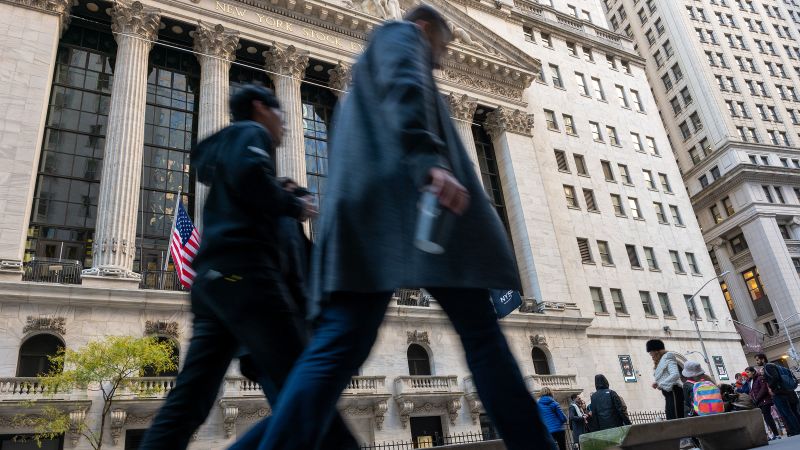A version of this story first appeared in CNN Business’ Before the Bell newsletter. Not a subscriber? You can sign up right here. You can listen to an audio version of the newsletter by clicking the same link.
Wall Street finally has the calendar on its side again.
The US stock market tends to be volatile during the late summer months, due to a lull in economic news and earnings to catalyze a rally. Investors also take off for vacation then, resulting in lower volumes and thus choppier trading.
That seasonal pattern proved almost prophetic this year: The market peaked promptly on July 31 and has struggled to find its footing since then. The S&P 500 index just logged its longest monthly streak of declines since March 2020, and the Dow Jones Industrial Average has given up most of its gains from earlier this year.
A look at seasonal patterns for this month suggests that the tides could be turning.
November has been the strongest month for stocks since 1950, according to LPL Financial. The benchmark index has declined for the month just once in the past 11 years, in 2021. As for the Dow, the blue-chip index has gained more than 1% on average in November over the last 100 years, Bespoke Investment Group data show.
Things already look promising for the market, two trading days into November. The S&P 500 on Thursday climbed 1.9% to log its best one-day gain since April. The Dow added 1.7%, its best daily gain since June.
Behind the rally? Investors seem optimistic that the Federal Reserve is done raising interest rates this year, after the central bank on Wednesday paused for a second consecutive meeting, leaving the benchmark lending rate at its highest level in more than 22 years.
Markets see a roughly 80% expectation that the Fed will hold rates steady again at its December policy meeting and are pricing in cuts as early as March, according to the CME FedWatch Tool. That’s despite Fed Chair Jerome Powell’s warning on Wednesday that the central bank has yet to even consider lowering rates.
Also helping stocks run higher is a slide in bond yields after the Fed hit pause. The yield on the 10-year US Treasury note fell on Thursday to 4.67%, compared to Wednesday’s close of 4.79%, well below the key 5% level it breached last month. Weaker oil prices — down about 3% this week — may be another supportive factor.
“Three consecutive months of selling pressure may have also exhausted sellers and left stocks approaching oversold levels,” said George Smith, portfolio strategist at LPL Financial.
Seasonal patterns bode well beyond just this month. The S&P 500 has gained an average 6.7% from November to April since 1990, according to CFRA data.
Of course, history is merely a guide, not a crystal ball into the future.
Mike Wilson, chief US equity strategist at Morgan Stanley, says the chances of a fourth-quarter rally have fallen, citing faltering consumer and business confidence, narrowing market breadth and lagged effects of the Fed’s interest rates as some of the challenges that he believes outweigh seasonal bullishness.
“We remain comfortable with our long-standing 3,900 year-end target for the S&P 500,” he wrote in a note on October 29. The S&P 500 closed Thursday at about 4,318.
Disney to acquire remaining stake in Hulu
Disney will acquire Comcast’s one-third stake in Hulu for an expected $8.61 billion, the company said this week.
The deal will put the streaming service entirely inside the Magic Kingdom when the transaction closes later this year, report CNN’s Liam Reilly and Oliver Darcy.
“The acquisition of Comcast’s stake in Hulu at fair market value will further Disney’s streaming objectives,” the company said in a short statement.
Wednesday’s deal brings to an end long-running speculation about the fate of Hulu but still requires an appraisal process that is expected to be completed in 2024 to further assess the streaming service’s fair value before a final sale price tag is agreed upon.
“We look forward to the appraisal process and the determination of Hulu’s fair market value which we expect will reflect the extraordinary value of the business,” Comcast said in a statement.
Read more here.
Bank of England downgrades UK economic growth forecast
The Bank of England downgraded its forecasts for UK economic growth Thursday and kept interest rates unchanged, even as it warned that the Israel-Hamas war could push up energy prices and inflation won’t return to target for another two years.
The central bank now expects gross domestic product to have flatlined in the July-to-September quarter and to grow just 0.1% in the current quarter, marking gloomier forecasts than its projections in August, reports my colleague Hanna Ziady.
“There are increasing signs that higher interest rates are weighing on economic activity and we see that in weaker activity data and in a range of business surveys,” Bank of England Governor Andrew Bailey told reporters.
The bank, which stopped raising rates in September after 14 successive hikes, thinks more than half of the impact of higher borrowing costs on GDP is still to hit the economy, which suggests that growth could slow even more sharply.
Read more here.
Read the full article here




